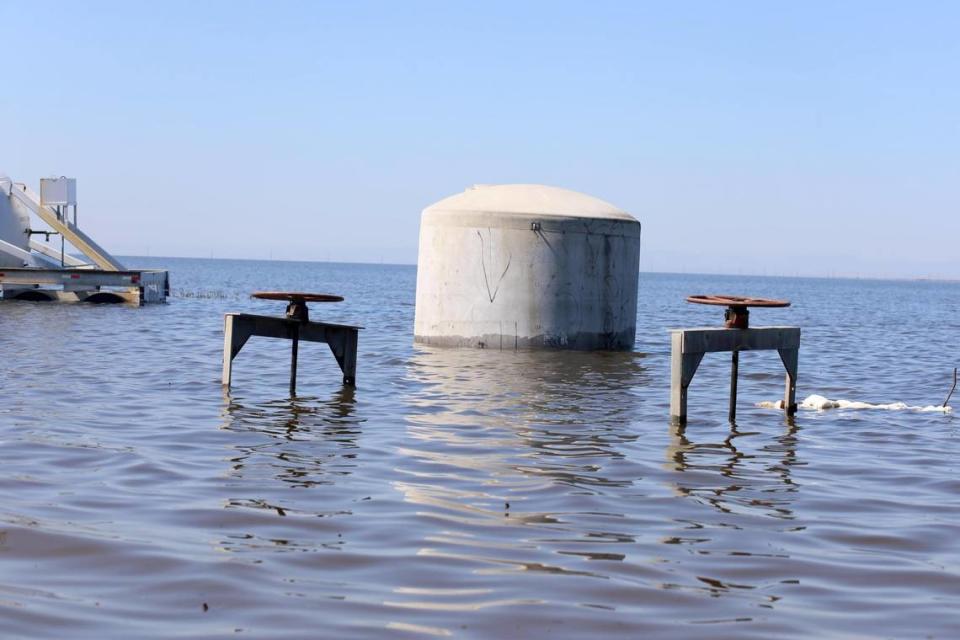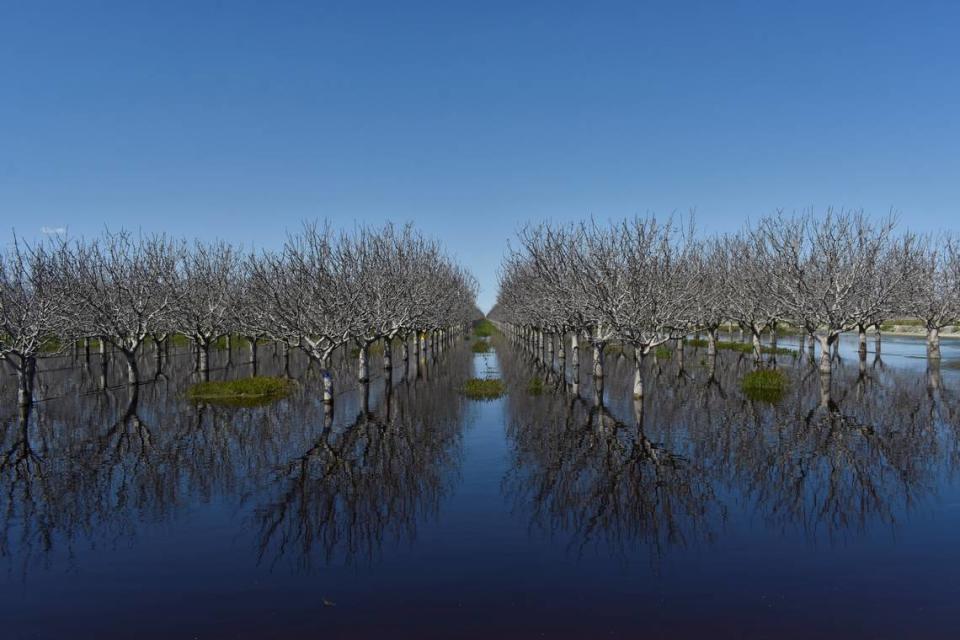‘Big Melt’ of Sierra Nevada snow will begin this weekend. Tulare Lake flooding to worsen
As temperatures warm up over the coming days across the central San Joaquin Valley, weather experts are predicting that a record snowpack in the southern Sierra Nevada will see an accelerated pace of melting, potentially adding to flooding woes on the Valley floor.
“The Big Melt is now officially arriving this weekend,” said Daniel Swain, a climate scientist at UCLA who has been monitoring the snow accumulation and snowmelt flood potential in California’s mountain ranges. “Flows on many rivers draining the central/southern Sierra will double or triple (with locally greater increases) as temperatures rise.
“Some rivers will exceed flood stage, and Tulare Basin flooding will worsen,” Swain said in a social media post Thursday.
Over the past few days, high temperatures in Fresno have climbed steadily, from a high of 66 degrees on Tuesday to 67 degrees Wednesday, 73 degrees Thursday and 81 degrees Friday, according to the National Weather Service office in Hanford.
Over the weekend, things will stay warm, at 83 degrees on both Saturday and Sunday. Monday is forecast to be slightly cooler, at 79 degrees, before temperatures rebound to 81 degrees on Tuesday, 88 on Wednesday and about 92 degrees next Thursday.
That generally corresponds to slowly declining volumes of water frozen in the snowpack of the southern Sierra Nevada — dipping gently from an estimated average water equivalent depth of 62 inches last weekend to just under 60 inches on Friday, the California Department of Water Resources reported.
As temperatures climb, even more of that snow will melt and flow downstream into rivers and lakes that eventually reach the Valley floor.
Guidance issued by the California Nevada River Forecast Center, a Sacramento-based arm of the National Oceanographic and Atmospheric Administration, indicates that the snowmelt will speed up over the five-day period ending April 26, and pick up even more steam between April 26 and May 1, in the San Joaquin, Kings, Kaweah and Tule river watersheds on the east side of the Valley.
The Kings, Kaweah and Tule rivers each ultimately feed into the long-dry — and this year reborn — Tulare Lake as heavy winter rains dumped so much water on the Sierra foothills that dam operators at Pine Flat Lake, Lake Kaweah and Lake Success had to make flood control releases. Much of that water ended up on what is now farmland in the old Tulare Lake bed in Kings and Tulare counties.

Forecast snowmelt volumes
On the San Joaquin River feeding into Millerton Lake behind Friant Dam, low and high flow five-day estimates of snowmelt are:
Through April 26: Estimated flows ranging from as low as 95,600 acre-feet to as much as 162,600 acre-feet.
April 26-May 1: Estimated flows ranging from as low as 170,600 acre-feet to as much as 324,200 acre-feet.
May 1-6: Estimated flows ranging from as low as 135,200 acre-feet to as much as 238,700 acre-feet.
May 6-11: Estimated flows ranging from as low as 99,600 acre-feet to 228,200 acre-feet.
An acre-foot amounts to about 326,000 gallons, or enough to flood an acre of land under one foot of water. Millerton Lake has a maximum capacity of about 520,500 acre-feet.
On the Kings River feeding into Pine Flat Reservoir behind Pine Flat Dam, low- and high-flow five-day estimates are:
Through April 26: Flows ranging from as low as 77,000 acre-feet to as high as 125,700 acre-feet.
April 26-May 1: Flows ranging from as low as 137,000 acre-feet to as high as 241,700 acre-feet.
May 1-May 6: Flows ranging from as low as 128,200 acre-feet to as high as 231,900 acre-feet.
May 6-11: Flows ranging from as low as 110,200 acre-feet to as much as 228,300 acre-feet.
Pine Flat has a maximum capacity of about 1 million acre-feet.
On the Kaweah River feeding into Lake Kaweah behind Terminus Dam east of Visalia, five-day estimates are:
Through April 26: Flows ranging from as low as 25,400 acre-feet to as much as 35,000 acre-feet.
April 26-May 1: Flows ranging from as low as 39,500 acre-feet to as much as 66,600 acre-feet.
May 1-5: Flows ranging from as low as 34,400 acre feet to as much as 57,100 acre-feet.
May 5-11: Flows ranging from as low as 24,700 acre-feet to as much as 52,500 acre-feet.
Lake Kaweah has a storage capacity of 185,630 acre-feet.
On the Tule River feeding into Lake Success behind Schafer Dam near Porterville, five-day estimates are:
Through April 26: Flows ranging from as low as 11,300 acre-feet to as much as 16,900 acre-feet.
April 26-May 1: Flows ranging from as low as 15,400 acre-feet to as much as 22,600 acre-feet.
May 1-6: Flows ranging from as low as 15,100 acre-feet to as much as 22,100 acre-feet.
May 6-11: Flows ranging from as low as 12,000 acre-feet to as much as 19,300 acre-feet.
Lake Success has a capacity of 84,095 acre-feet.
Data from the California Department of Water Resources shows that dam operators at most of the foothill lakes have been releasing water steadily to make room for the coming snowmelt even as water continues to pour into them.
At Friant Dam, the volume of water stored in Millerton Lake on April 1 was almost 327,000 acre-feet; by Thursday, that had been cut by more than half, to less than 160,000 acre-feet. In the meantime, the average flow into the lake since April 1 has averaged about 6,600 cubic feet per second (cfs), peaking at almost 9,700 cfs late last week.
A cubic foot of water amounts to almost 7.5 gallons.
At the other area reservoirs, storage changes are:
Pine Flat Dam: Water storage at Pine Flat Reservoir has been cut by about 30.6% this month, from almost 716,000 acre-feet on April 1 to about 497,000 acre-feet on Thursday. Inflow to the lake has averaged 10,687 cfs, peaking at 12,222 cfs on Thursday.
Terminus Dam: Water storage at Lake Kaweah has been cut by more than two-thirds this month, from more than 119,000 acre-feet on April 1 to just over 39,200 acre-feet on Thursday. Inflow to the lake has averaged 2,223 cfs, peaking at almost 2,800 cfs on April 11.
Schafer Dam: Water storage at Lake Success has increased by about 26% since April 1, climbing from just under 44,000 acre-feet at the beginning of the month to 55,363 acre-feet on Thursday. Inflow to the lake has averaged about 1,345 cfs, peaking at almost 1,600 cfs on April 12.
The Big Melt is now officially arriving...this weekend. Flows on many rivers draining the central/southern Sierra will double or triple (with locally greater increases) as temperatures rise. Some rivers will exceed flood stage, & Tulare Basin flooding will worsen. #CAwater #CAwx https://t.co/z2VMemjVpw
— Daniel Swain (@Weather_West) April 20, 2023


